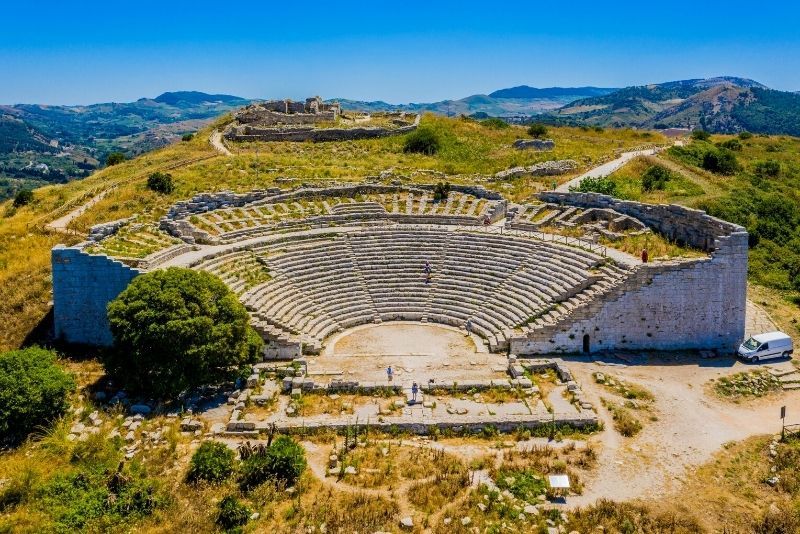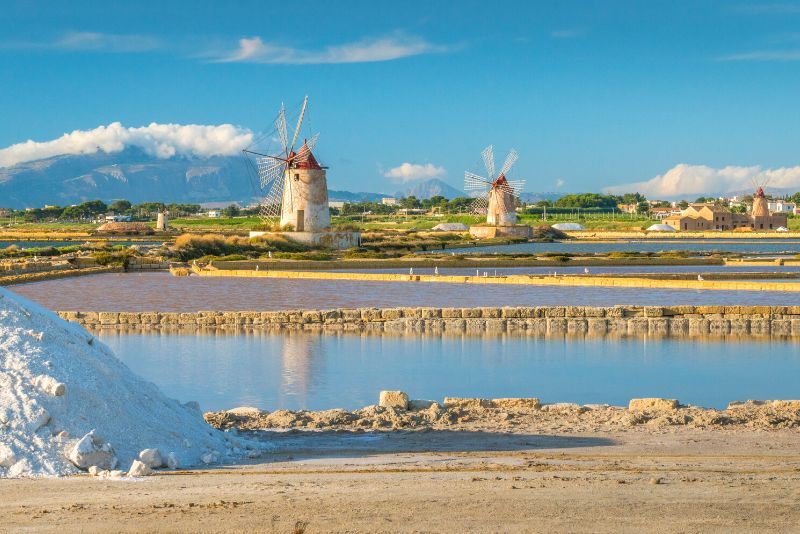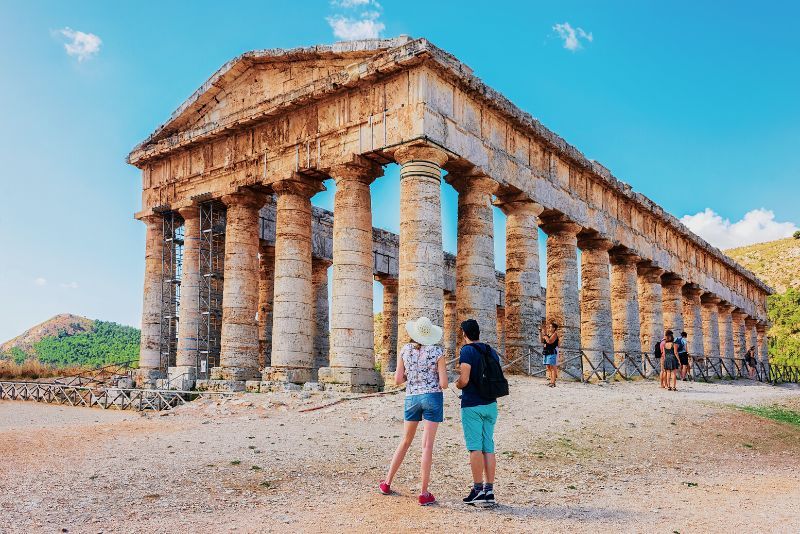Segesta: Day Trips and Tours from Palermo
Italy is full of incredibly well-preserved remains from Ancient Greek and Roman Times standing impressively, waiting to be admired by tourists. What sets Segesta apart is that the ancient city was built by the Elymians — a local Sicilian tribe that dates back to the 11th century B.C.
A Segesta day trip from Palermo is within easy reach and it's well worth expanding your historical knowledge of the people inhabiting the region in the Bronze Age.
Italy is full of incredibly well-preserved remains from Ancient Greek and Roman Times standing impressively, waiting to be admired by tourists. What sets Segesta apart is that the ancient city was built by the Elymians — a local Sicilian tribe that dates back to the 11th century B.C.
A Segesta day trip from Palermo is within easy reach and it's well worth expanding your historical knowledge of the people inhabiting the region in the Bronze Age.

(0/24) checking Musement...
Italy is full of incredibly well-preserved remains from Ancient Greek and Roman Times standing impressively, waiting to be admired by tourists. What sets Segesta apart is that the ancient city was built by the Elymians — a local Sicilian tribe that dates back to the 11th century B.C.
A Segesta day trip from Palermo is within easy reach and it's well worth expanding your historical knowledge of the people inhabiting the region in the Bronze Age.

How to get to Segesta from Palermo?
Segesta is located in the northwestern part of Sicily, which is just off the coast of mainland Italy. It is nearly 80 kilometers from the city of Palermo and can be reached within an hour.
From Palermo to Segesta by car
The journey to Segesta by car is easy as it follows the E90 all the way from Palermo to the ancient city. The drive takes just under an hour and turns off the motorway at the Segesta exit.
From Palermo to Segesta by bus
There is one company that operates a direct service to Segesta from Palermo — Tarantola. The bus departs from Via Paolo Balsamo three times a day and the return journey runs twice daily. The jaunt to Segesta takes 1.5 hours and costs €11.20.
Guided tour to Segesta from Palermo
Day tours to Segesta take care of transportation and last between seven and eight hours. You'll meet between 8 AM and 8:30 AM, either at a centrally located spot in Palermo or outside of your hotel.
How much does the entrance ticket to Segesta cost?
- Adults (25+): €6
- Young adults (18-25): €3
- Children under 18 (EU only): Free
If you wish to visit the amphitheater located at the top of Mount Barbaro on your Segesta day tour, you can use the private shuttle service which costs €2 per ticket.
What is the typical itinerary of a day tour to Segesta from Palermo?
Day tours meet in a central location in Palermo and head towards the historic town of Erice. The town was associated with the goddess Venus through its temple that was dedicated to her. The building no longer stands, but there is plenty to see in the ancient town such as its cathedral and castle.
After some free time, you'll drive through the Trapani salt pans and have the opportunity to see salt being harvested. The last stop of the day is at the Elymian city of Segesta where you'll be able to roam the archaeological site.
The main reason the town attracts visitors is for its celebrated Doric temple. Built in the 5th century B.C., the temple was built on a hilltop and showcases its magnificence from miles away.
Afterward, you'll return back to the bus and end your day trip to Segesta back where it started — in Palermo.
What kinds of tours are available to go to Segesta?
There are several different tours that visit the archaeological site of Segesta. Typically, day trips visit extra sites on the way.
Day trip to Segesta plus Erice and Trapani from Palermo
Segesta day trips often work Erice and Trapani salt flats into the itinerary, and the three sites give a well-rounded view of Sicily's history. You'll either have guided or self-guided tours of both the ancient town of Erice and the ruins of Segesta.
Your tour bus will drive through the Trapani salt pans where you can see how the salt you sprinkle on your dinner is harvested from the sea.

Guided tours to Segesta from Palermo
There is only so much you can learn from guiding yourself around the ancient ruins of Segesta. A guided tour is a great choice for those wanting to delve deeper into the history behind the city.
A tour guide will take you on a trip back in time to the rule of the Elimi people. You'll meander through all 12 of the archaeological sites that remain from the period and learn about their links to the past.
Private tour to Segesta plus Erice and Selinunte from Palermo
Private tours allow for a little flexibility in your schedule, and stop at both Segesta and Erice like most excursions. However, this day trip also stops at the Selinunte Archaeological Park — an ancient city built by the sea in the seventh century B.C.
Private tour to Segesta plus Monreale from Palermo
Some private day tours to Segesta also include the Monreale monastery which was built in the 12th century. The combination of influences is what makes the monastery one of a kind, with inspiration drawn from Norman, Arab and Byzantine architecture.
How much does a tour to Segesta from Palermo cost?
Day trips to Segesta, Erice and the Trapani salt pans include round-trip transportation and a multilingual driver. In some cases, your driver will provide you with a guided tour of the attractions.
Entrance fees for the Doric temple at Segesta and the cathedral at Segesta are at your own expense. Prices start from €70.
Guided tours deliver in-depth knowledge about the ancient city and its people, and include a tour guide for two people. Entrance to the park and transportation are at your own expense. You'll pay around €350 for a four-hour tour.
Private tours that make a stop at Selinunte include hotel pickup and drop-off, and an English-speaking driver. You can expect to pay €213 and the tour lasts seven hours.
Private day tours of Segesta and Monreale include hotel pickup and drop off, as well as a private tour guide to show you around the sites. Prices start at €304.
What will you see and do in Segesta?
The city of Segesta was built on the top of Mount Barbaro by the ancient Elymians. Though relatively unheard of, the Elymians were one of three Sicilian tribes and have been traced back to the 11th century B.C.
The standout attraction of Segesta is its Doric temple which has been standing since the 5th century B.C. Interestingly, despite how intact the monument remains, the temple was never finished, although this doesn't take away from the magnificence you can see today.

"Doric" refers to the architectural style of the 36 plain columns that form the temple and connect to the foundations without a base.
Once you've viewed the Elymian masterpiece, take the shuttle service up the hill to discover the rest of the city. You'll see remains of the amphitheater, church and public forum, as well as ancient Greek and Roman street pavings, which combine three historical periods into one.
What are the opening times?
The opening times for Segesta alter throughout the year.
- 9 AM - 6:30 PM — March 1 - March 30
- 9 AM - 7:30 PM — March 31 - Sept. 30
- 9 AM - 6:30 PM — Oct. 1 - Oct. 26
- 9 AM - 5 PM — Oct. 27 - Feb. 28
When is the best time to visit Segesta?
Segesta has the longest opening hours between April and September, and during this time, the site is visually astounding. If you want to take the most impressive photographs, visit in May or June when there are wildflowers growing around the site.
These shoulder months range between 21 and 25 degrees Celsius and also avoid the crowds that can be seen during July and August.
Travel tips
- There is plenty to be seen on a day trip to Segesta, so make sure to bring your camera along.
- If you would like to learn about the ancient Elymians, choose a tour that includes a professional guide.
- Segesta excursions spend most of the day outside. If you are visiting in the summer months when temperatures rise to around 28 degrees Celsius, bring provisions for the sun. These include a sunhat, sunscreen and plenty of water.
